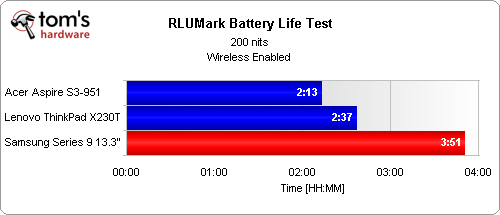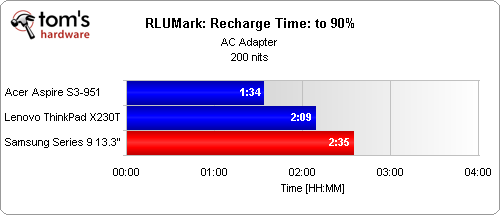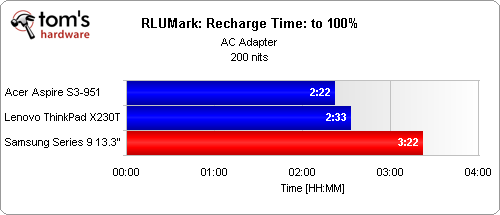Samsung's Series 9 13.3" Ultrabook For 2012: Thinner And Lighter
Battery Performance: Four Hours Of Real-World Use
RLUMark is a “Real Life Use” benchmark that models what you might experience from day-to-day experiences with battery life. The metric is programmed to simulate a user typing at ~45 WPM and reading at ~200 WPM.
This session consists of the following, run sequentially in the order listed:
- 24 minutes of Wikipedia reading (four entries): one tab per entry
- 4 minutes of Amazon.com: two tabs
- 3 minutes of CNN.com: two tabs
- 2 minutes of Google Finance: one tab
- 2 minutes of Accuweather: one tab
- 25 minutes of Flash 10.1 video (YouTube 360p, H.264, hardware acceleration enabled): one tab
Even though the 13.3" Series 9 comes with a smaller battery pack than Lenovo's ThinkPad X230T, it's able to achieve almost four hours in our battery life test. This is a direct result of the Ultrabook's 17 W Core i7-3517U. Lenovo's 35 W Ivy Bridge-based processor is potentially faster, but it necessitates a larger battery as well.
Charging a battery quickly is more convenient, but it's harder on the power source itself, cutting into its service life. Vendors generally slow the charge rate in the 80% to 95% capacity range to stave off this effect. That's why charging from 0% to 10% is faster than 90% to 100%.
The time it takes to recharge a battery usually correlates with battery life, and that's what we see from Samsung's 13.3" Series 9. However, considering it takes nearly three-and-a-half hours to reach a full charge; true road warriors might even want to look into an external battery.
Get Tom's Hardware's best news and in-depth reviews, straight to your inbox.
Current page: Battery Performance: Four Hours Of Real-World Use
Prev Page Display Performance: SuperBright Plus, Indeed Next Page Samsung 13.3" Series 9: Better In 2012-
mayankleoboy1 Is the QS balance between quality/speed determined by any OEM customised driver ?Reply
Because this samsung notebook takes more time than other i7's in 'quality' setting, but lesser time in 'performance' settings.
-
mayankleoboy1 in the screen quality/brightness benchmark, why u no compare with the new rMBP ?Reply -
joytech22 esreverDon't samsung ultra books overheat a lot?What..? No. That's the dell's and I'm not even joking.Reply
I was watching a demo and their Dell XPS ultrabooks with GT640's in them continuously overheated during the demos and lowered the FPS catastrophically low.
They have these ultrabooks at my local Jb HiFi (Well.. the i5 version at least) and it was cool to the touch and very solid (I've noticed even Acer's ultrabooks don't feel flimsy as sh*t like their notebooks). -
Yargnit Looks awesome, but unfortunately the 'ASUS Zenbook Prime UX31A' simply trounces it on a price/performance ratio. If there was a base model out for under $1200, preferably at $1000 like the Asus it'd be a very solid option. But the Asus for $1000 is just such a better value that it kind of make this look like a weak effort, which is too bad because it actually looks like a solid system.Reply -
ojas BTW i wish you'd have included a desktop processor's QuickSync benchmark for reference...Reply -
ojas Hmmm...interesting, one of the most positive review's i've seen of an ultrabook-class notebook...i just have two questions:Reply
1)Is the touchpad annoying? Compared to Apple's touchpads, for example.
2)Can you keep it in your lap, sitting or lying down slightly (you know, with the notebook against your knees)? Or does it get too warm?
These two are deal breakers for me, personally. So is the keyboard, but you've clearly stated what's wrong with that (touchpad too, but just wanted to know if it's a noticeable annoyance). -
veroxious BTW why was the Asus UX31A not used in the comparative benchmarks? We have the same form factor, Ivy Bridge i7 processor, 256GB SSD BUT the Asus sports a Full HD IPS panel that really impressed me for less money.Reply -
cangelini mayankleoboy1in the screen quality/brightness benchmark, why u no compare with the new rMBP ?I haven't gone out to buy one yet :)Reply


